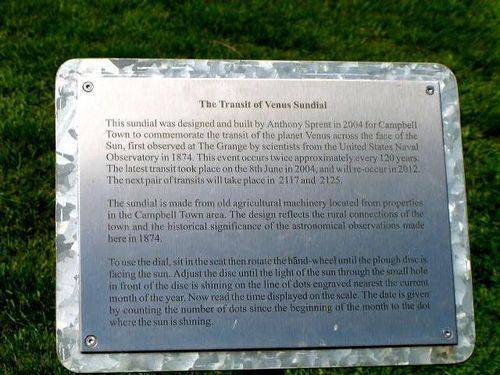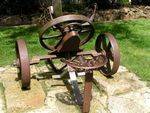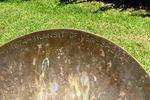
Home » Themes » Technology » Science
Transit of Venus Print Page 
The sundial commemorates the viewing of the transit of Venus in 1874 and 2004.
Despite being a rare astronomical event, transits of Venus have helped astronomers measure the distance to the Sun, create Internet audience records, and lead to the mapping of the east coast of Australia. The first attempt to observe the transit from Australia was organised by New South Wales Government astronomer Mr Henry Chamberlain Russell on 9 December 1874.
In addition to observing the transit from Sydney Observatory, he sent three observing parties to the Blue Mountains, Eden and Goulburn. The transit was also viewed from Campbelltown in central Tasmania, by the United States Naval Observatory. The transit of Venus on 8 June 2004 was one of the most viewed in history.
Location
| Address: | Midland Highway, Valentine Park, Campbell Town, 7210 |
|---|---|
| State: | TAS |
| Area: | AUS |
| GPS Coordinates: | Lat: -41.928698 Long: 147.494486 Note: GPS Coordinates are approximate. |
Details
| Monument Type: | Structure |
|---|---|
| Monument Theme: | Technology |
| Sub-Theme: | Science |
| Designer: | Anthony Sprent |
Dedication
| Approx. Monument Dedication Date: | 2004 |
|---|
The Transit of Venus Sundial.
This sundial was designed and built by Anthony Sprent in 2004 for Campbell Town to commemorate the transit of the planet Venus across the face of the sun, first observed at The Grange by scientists from the United States Naval Observatory in 1874. This event occurs twice approximately every 120 years. The latest transit took place on the 8th June in 2004, and will reoccur in 2012. The next pair of transits will take place in 2117 and 2125. The sundial is made from agricultural machinery located from properties in the Campbell Town area.
The design reflects the rural connections of the town and the historical significance of the astronomical observations made here in 1847. To use the dial, sit in the seat then rotate the hand-wheel until the plough disc is facing the sun. Adjust the disc until the light of the sun through the small hole in front of the disc is shining on the line of dots engraved nearest the current month of the year. Now read the time displayed on the scale. The date is given by counting the number of dots since the beginning of the month to the dot where the sun is shining.







